Let’s get right to the point: bouncing between your inbox, pointless meetings, and group chat notifications is no way to get ahead in today’s information economy.
These are markers of busyness, not productivity. They won’t help you to deepen your writing practice, master a programming language, or grow your business. In fact, these activities won't aid you in any number of the ambitious goals you’ve set for yourself.
Instead, succumbing to these attention traps leads you off the path of excellence and down the road of mediocrity. To be truly exceptional at the work you do and to gain recognition for it, you’ll need to adopt a different strategy entirely.
Enter “deep work.”
The concept was coined by Cal Newport, a renowned author and computer science professor at Georgetown University, in a 2012 blog post and expanded upon in his 2016 bestselling book, Deep Work: Rules for Focused Success in a Distracted World. By Newport's definition, deep work refers to:
“Professional activity performed in a state of distraction-free concentration that push your cognitive capabilities to their limit. These efforts create new value, improve your skill, and are hard to replicate.”
This likely isn’t the form of work that naturally fills your day. On the contrary, if you aren’t intentional about how you spend your time, your work hours slip away towards activities that Newport refers to as “shallow work”:
“Non-cognitively demanding, logistical-style tasks, often performed while distracted. These efforts tend to not create new value in the world and are easy to replicate.”
In the present and future, excellence won’t be achieved by scratching the surface. As information expands and shifts, keeping up involves learning hard things quickly and applying that knowledge to produce work that’s exceptional.
This is precisely what deep work will help you accomplish. As Newport puts it, “The ability to perform deep work is becoming increasingly rare at exactly the same time it is becoming increasingly valuable in our economy. As a consequence, the few who cultivate this skill and then make it the core of their working life will thrive.”
This is an actionable guide based directly on Newport's strategies in Deep Work. While we fully recommend reading the book in its entirety, this guide distills all of the research and recommendations into a single actionable resource that you can reference again and again as you build your deep work practice. You’ll learn how to integrate deep work into your life in order to execute at a higher level and discover the rewards that come with regularly losing yourself in meaningful work.
Learn How to Practice Deep Work
Many of us have forgotten how to focus deeply on a single task or never really learned to in the first place. In school, you may have done well enough by practicing mostly shallow work on a day-to-day basis, with the occasional deep work session a few times per semester to write a last-minute paper or cram for a final exam.
Learning how to practice deep work requires you to be more intentional than you’ve ever been in sitting down regularly to concentrate on high-impact tasks. These strategies will help you select your preferred form of deep work, build a routine from scratch, and provide operating principles and tactics for embracing the power of directed focus.
Choose Your Deep Work Strategy
While you may be convinced of the value of deep work, you may be unsure of how to implement it in your life. Newport describes four different types of deep work scheduling you can choose from:
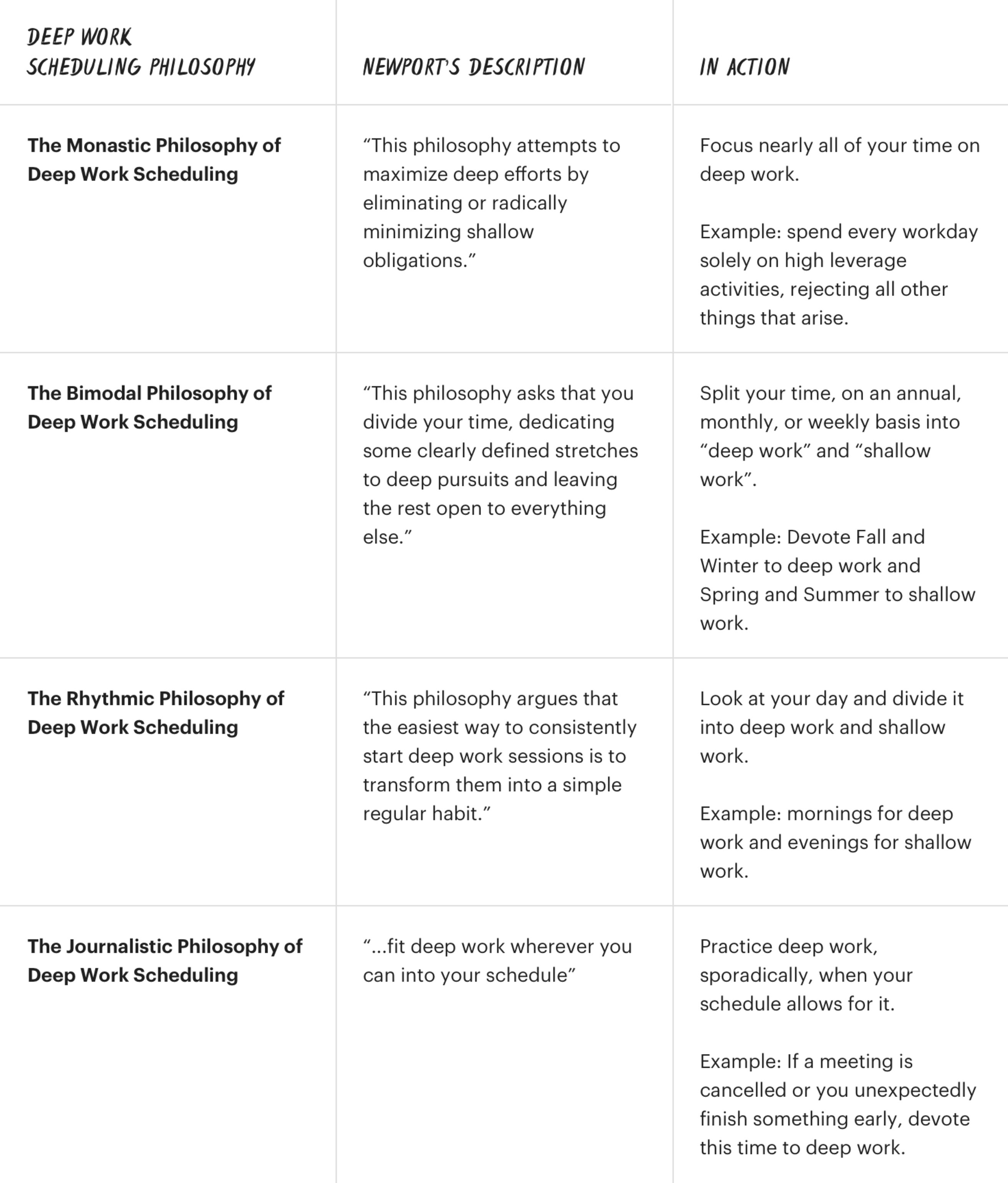
All four of these philosophies have their pros and cons that should be carefully considered:
- The Monastic Philosophy of Deep Work Scheduling is the most dedicated form of deep work and involves spending all of your working hours on a singular high-level focus. While this philosophy has the highest potential for reward and the lowest level of context switching, it's unrealistic for most people who are required to perform various kinds of work in their role. It also blocks the potential for new opportunities, as your default response to commitments that arise is “no.”
- The Bimodal Philosophy of Deep Work Scheduling allows for a high amount of deep work while enabling you to maintain other activities in your life that you find valuable. Successfully adopting this philosophy requires the flexibility to arrange your year, months, or weeks as you see fit into larger chunks of deep work.
- The Rhythmic Philosophy of Deep Work Scheduling is ideal for individuals with a fairly static schedule. If you can anticipate what most of your days will look like, it’s feasible to block off several hours every day for deep work, thereby getting into a daily "rhythm" and leaving the rest of your hours for shallow work.
- The Journalistic Philosophy of Deep Work Scheduling is an option for people who are constantly on the move with little to no regularity to their days. This method demands vigilance with your time and the keen ability to notice natural ebbs and flows in your day where you may be able to fit in 30 minutes or an hour or two of deep work. Unfortunately, this method is not for beginners and is likely to fail for people who are not experienced in deep work.
Select the deep work philosophy that best suits your work and life. Also, feel free to experiment before you land on a method that finally takes hold in your schedule.
Build a Deep Work Routine
Practicing intention with your time and considering when you’ll fit in periods of focus is an important part of succeeding with a deep work habit.
Make the following considerations when building a deep work ritual:
- Location - Choose a space that’s distraction-free and conducive to long periods of focus. In the absence of such a location, opt for noise-canceling headphones that will shut out the world while you work and notify your brain that it’s time to focus. Try to be consistent with your environment; familiarity will allow you to get into deep work mode more quickly.
- Duration - Before you start a deep work session, determine precisely how much time you’ll devote to the task ahead. Start small, with as little as 15 minutes, and work your way up to longer sessions. Your ability to focus will improve as you flex your deep work muscle.
- Structure - Set structure for yourself and define what deep work mode looks like. For instance, will your phone be off or on? Will you let yourself check the internet? Can you walk to the kitchen to get a snack? How will you measure the success of a session (i.e., pages read, lines coded, words written)? Whatever your rules, make them explicit and follow them for the duration of your deep work session.
- Requirements - After a few sessions of focused work, you’ll learn what you require to support your commitment to deep work. This may include a specific type of music, your favorite beverage, or access to specific software. Always have everything you need before diving in.
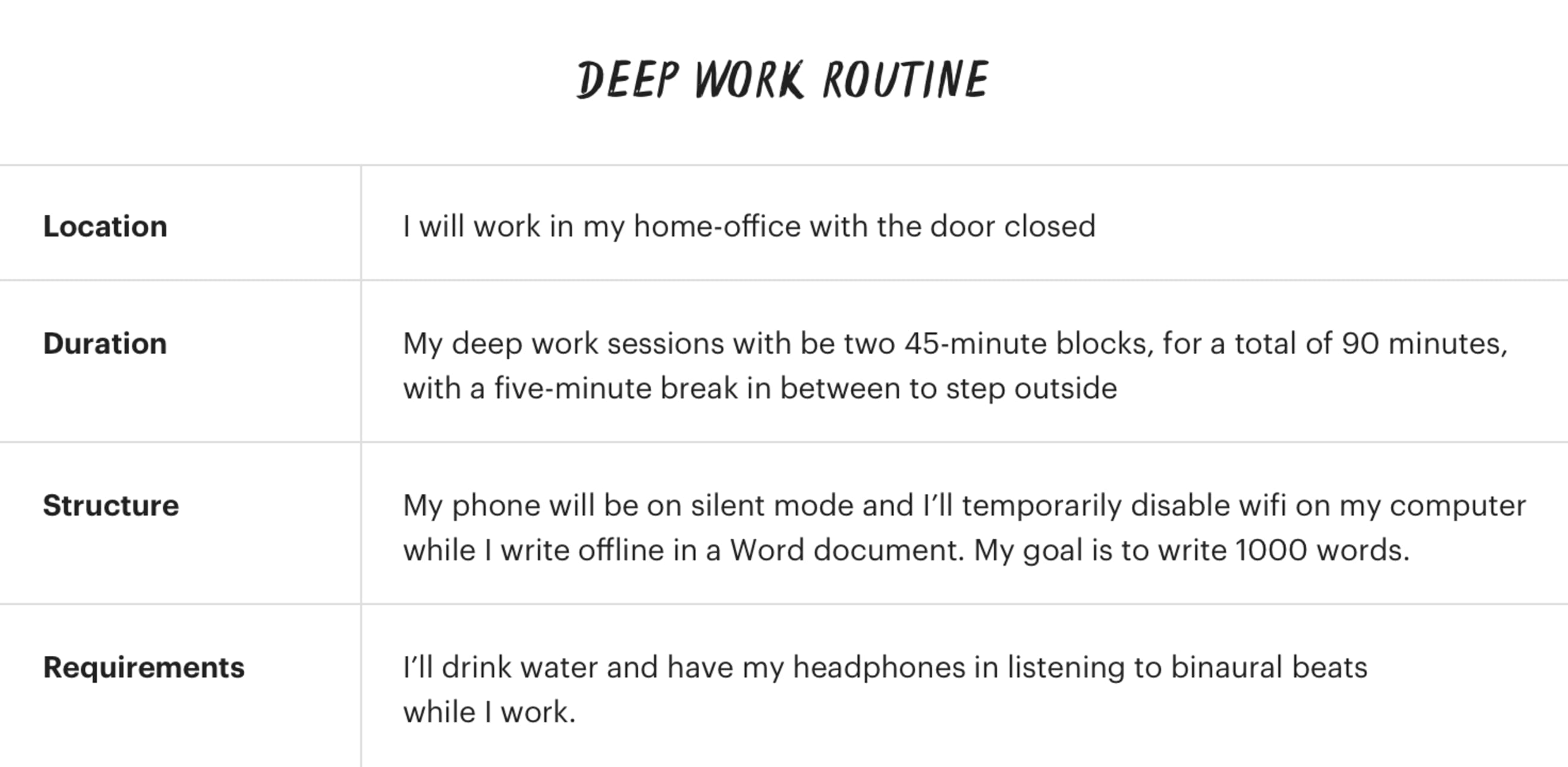
Execute a Grand Gesture
Sometimes day-to-day attempts at deep work don’t feel adequate for a goal we’re striving towards. In this case, Newport suggests enacting a “grand gesture”:
“By leveraging a radical change to your normal environment, coupled perhaps with a significant investment of effort or money, all dedicated toward supporting a deep work task, you increase the perceived importance of the task.”
For instance, if you’re working on an important project but feel constrained or unmotivated by your office setting, initiate a grand gesture by asking your manager to let you work from home for an entire week to get it done. Likewise, spending an entire day writing in the library instead of chipping away at your paper in 20-minute increments is a radical change. A popular example of this deep work tactic is Bill Gates’ famous “think week,” where he spends two weeks alone at his cottage twice a year, reading and thinking about the future of Microsoft.
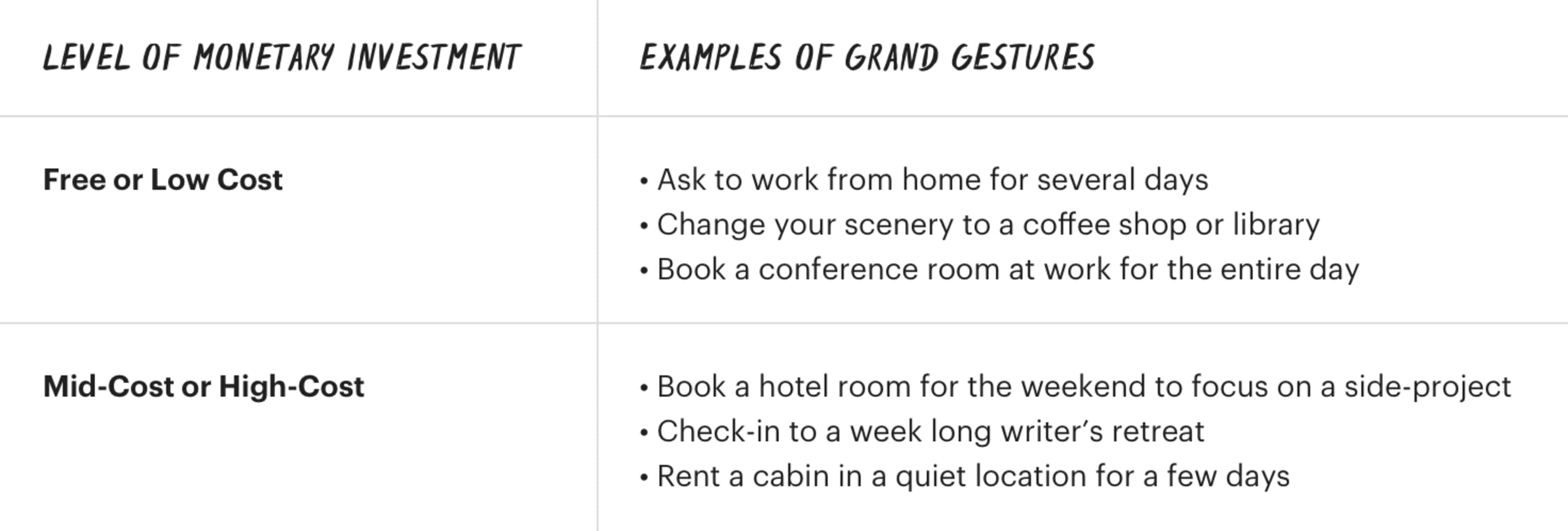
Enacting the grand gesture lets you harness the power of novelty (and, often, quiet) to get more done than you usually would. By alerting your mind to the importance of a task through a change in your regular routine, you’ll access your ability to work deeply more readily.
Work Collaboratively With Others
Prioritizing deep work often means working alone. However, working with others can unleash the power of “serendipitous creativity” that we often can’t generate by ourselves. Luckily, committing to a deep work practice doesn’t mean we’ll be unable to reap the benefits of collaboration. On the contrary, they feed into one another beautifully: time spent learning from others can be explored in more depth once we’re alone in deep work mode. The mistake lies in attempting to combine the two, as is often the justification behind open-floor offices.

Additionally, you can practice “collaborative deep work,” in which you work with someone on a problem, both pushing each other towards great outputs along the way. While time for solo deep work remains important and is something employers should prioritize, collaboration is a powerful tool that should be used regularly.
Operate Like a Billion Dollar Company
In Deep Work, Newport introduces us to the concepts laid out in the book, The 4 Disciplines of Execution: Achieving Your Wildly Important Goals. While intended for companies, these strategies are also valuable to consider as an individual.
Discipline #1: Focus on the Wildly Important - Direct your effort to your most important goals during your deep work hours. Keep your biggest objectives at the forefront of your mind to make it easier to ignore distractions that don’t serve your long-term goals. Try using sticky notes on your desk that list out your top priorities so you don’t forget them.
Discipline #2: Act on the Lead Measures - While you can attempt to maximize your lagging measure (i.e., number of blog posts published), it may be more valuable to optimize for your lead measure (i.e., number of hours spent writing in deep work). By increasing the number of hours you spend per week in a state of focused concentration, you’ll naturally be in a strong position to accomplish what you set out to.
Discipline #3: Keep a Compelling Scoreboard - Keep count of how many hours you spend in deep work mode and display your tracking somewhere visible to keep you motivated. Newport suggests keeping a pen-and-paper tally of how many hours you spend on deep work. Alternatively, you can automate your scoreboard with time-tracking tools like RescueTime.
Discipline #4: Create a Cadence of Accountability - In the absence of an accountability buddy, keep your word to yourself by committing to daily or weekly reviews of your progress. Check-in on your scorecard and assess why you may be falling short of the goals you’ve set. If you’re exceeding them with ease, it may be time to push yourself further.
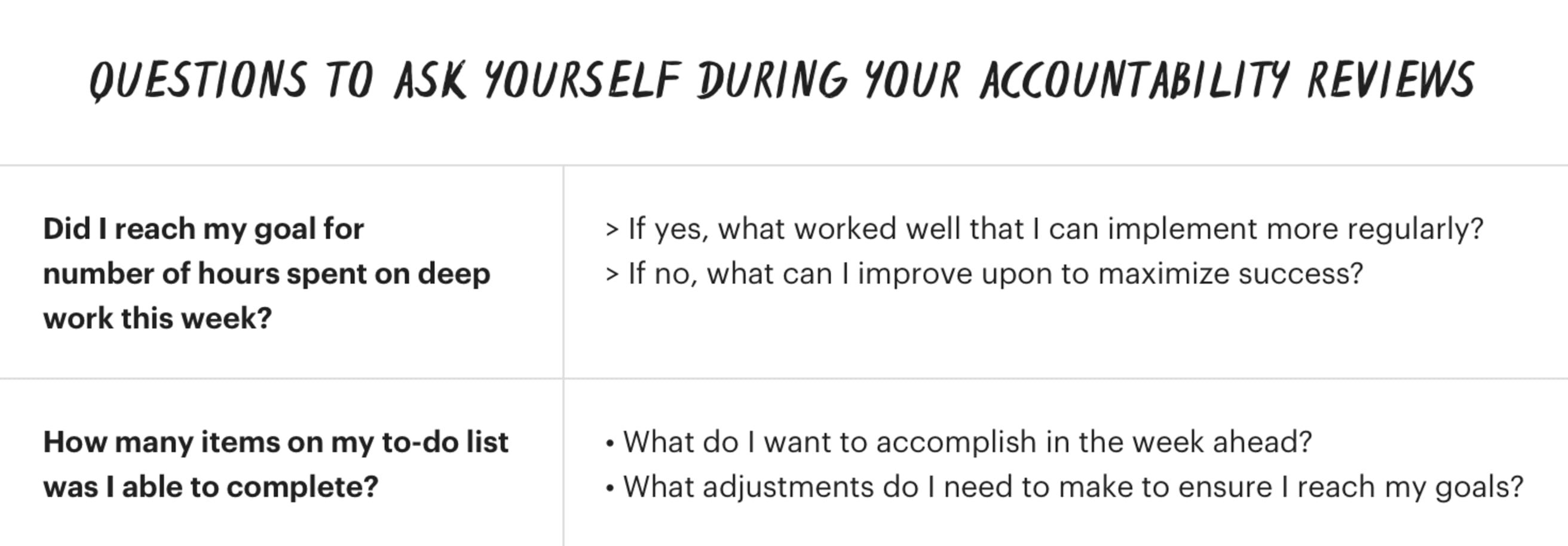
Prioritize Downtime
The deep work method isn’t only about work - it’s also about what you do when your workday is complete. Newport provides compelling reasons why working long hours without downtime can be detrimental to a deep work practice. Making downtime a priority is key because “regularly resting your brain improves the quality of your deep work.”
- Downtime Improves Our Thinking - Have you ever hit a roadblock in your work and ended the day in frustration, only to come back the next day with a perfectly formed solution? This is the power of the pause. Allowing your mind to rest lets you work through complex challenges with greater clarity than if you powered on empty. As Newport notes, “Providing your conscious brain time to rest enables your unconscious mind to take a shift sorting through your most complex professional challenges.”
- Downtime Replenishes Our Ability to Practice Deep Work - Deep Work makes the case that “you can restore your ability to direct your attention if you give this activity a rest.” After work, don’t direct your attention to high-priority tasks. Instead, give your mind uninterrupted rest through activities like gathering with friends or family, cooking, or walking in nature. Adversely, sneaking in extra emails or group chat conversations does not allow for true rest.
- Our Ability for Deep Work is Finite - Unfortunately, as valuable as deep work is, it can’t be done in unlimited quantity. Newport suggests the upper limit for deep work per day is four hours. Beyond this, our ability to direct focused attention diminishes. Given this, there is plenty of time in the evening to make room for the downtime that will serve your deep work sessions the following day.
Enhance Your Ability to Do Deep Work
You’re now familiar with the basics of deep work. It’s time to move towards strengthening the practice and getting the most out of deep work by conditioning your mind. Concentration isn’t a given. It requires practice over time to develop this skill.
Distractions are the enemy of deep work. Unfortunately, they’re everywhere in the form of your Twitter timeline, Instagram feed, Slack notifications, and email inbox. You can start the day with the best of intentions, an ample to-do list, and a game plan to get everything done. Yet, the hours slip, and you fail to accomplish anything meaningful. Newport makes this important point: “Efforts to deepen your focus will struggle if you don’t simultaneously wean your mind from a dependence on distraction.”
This section emphasizes the mental tactics that can be used to hone our ability to concentrate for long periods of time.
Make Focus Your Default Mode
As a general rule, Newport suggests the following: “Schedule in advance when you’ll use the Internet, and then avoid it altogether outside these times.”
Rather than switching back and forth between distraction and work, lowering your ability to perform the latter, keep off distracting websites and apps for a predetermined amount of time. Simply put, make “offline” your default.
Here are several strategies to help improve your focus and get better at resisting distraction.
- Set up blocks of time to answer emails rather than living in your inbox all day.
- If you get stuck and need to go online to check something, resist the urge and carry on with Deep Work or switch to another offline activity
- Block off time online even while you’re at home
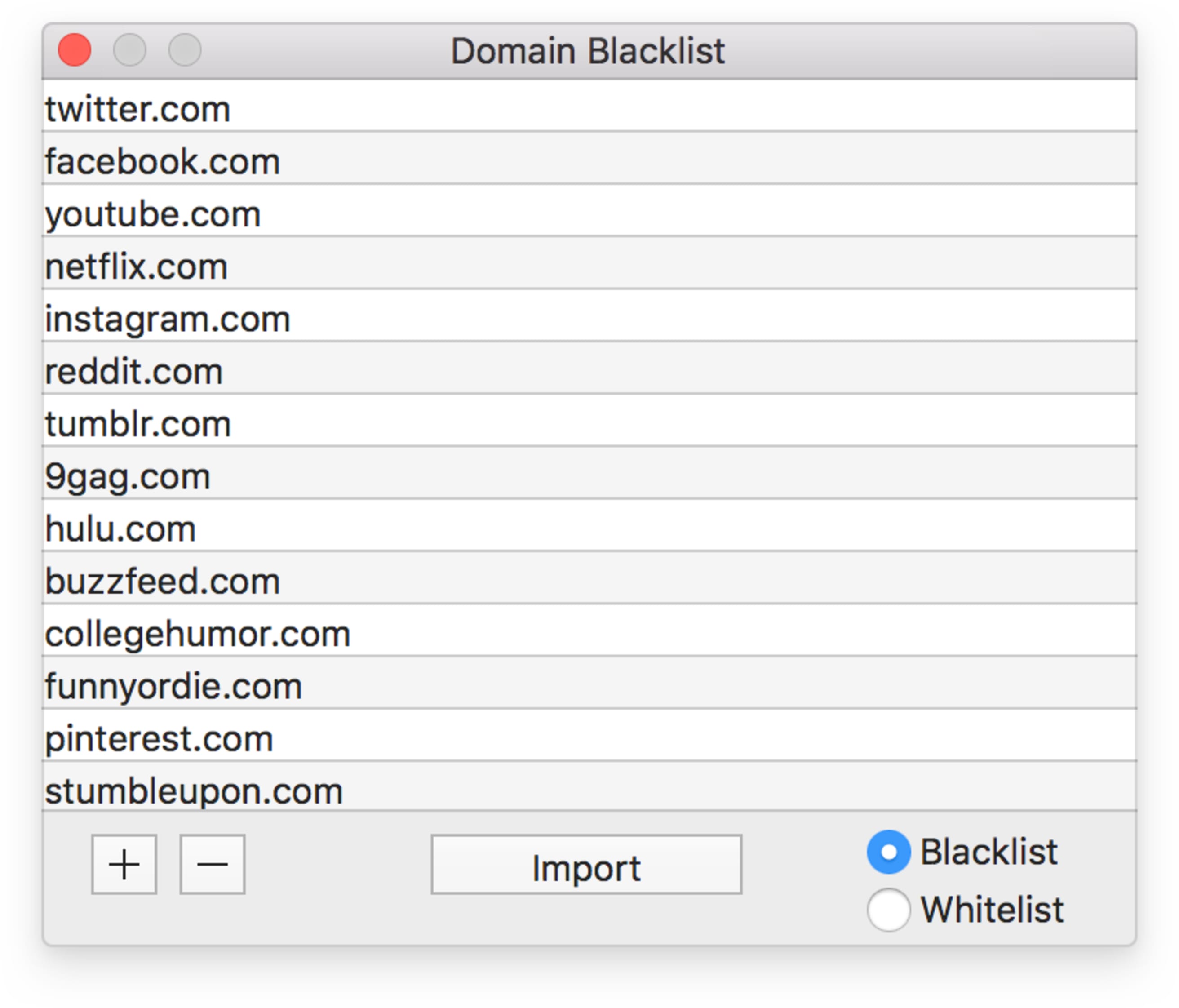
Add the Pressure of Time
One strategy that can help intensify deep work is imposing time limits on yourself. These time limits should stretch your abilities but not be impossible to accomplish. For instance, you might guess that researching a topic for a 1500-word essay takes around 3 hours. This strategy proposes that you give yourself 1.5 hours instead.
In the presence of a smaller time window, we’re forced to leverage deep concentration to finish the task. In our race against the clock, we utilize every strategy at our disposal to improve our efficiency. Newport describes this as “interval training for the attention centers of your brain.”
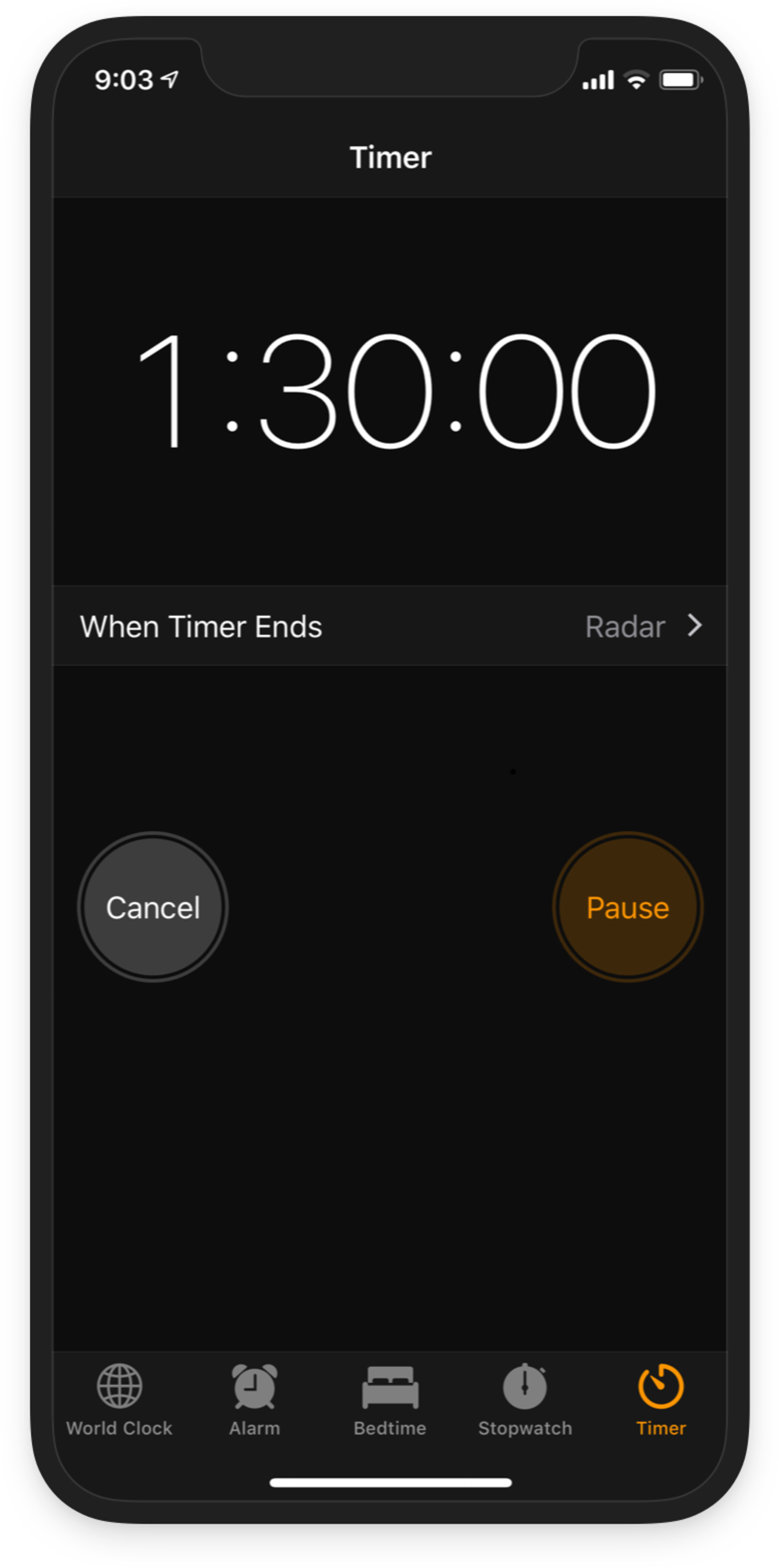
Start small by trying out this method once a week, and start adding these interval sessions more frequently.
Make Space for Deep Thinking
Mindfulness meditation asks practitioners to repeatedly bring your attention back to your breath, heartbeat, or another object of focus when your mind wanders. The practice of “productive meditation” asks us to do something similar:
“The goal of productive meditation is to take a period in which you’re occupied physically but not mentally—walking, jogging, driving, showering—and focus your attention on a single well-defined professional problem.”
Rather than using the time we spend folding laundry or doing the dishes with a podcast, audiobook, or phone call, Newport suggests spending two or three times per week in a state of “productive meditation.” During this time, contemplate and work through a challenging problem. This practice helps you improve your ability to think deeply and direct your attention while ignoring distractions (namely, other thoughts).
Here are some problems you may encounter while attempting productive meditation and how to curtail them:
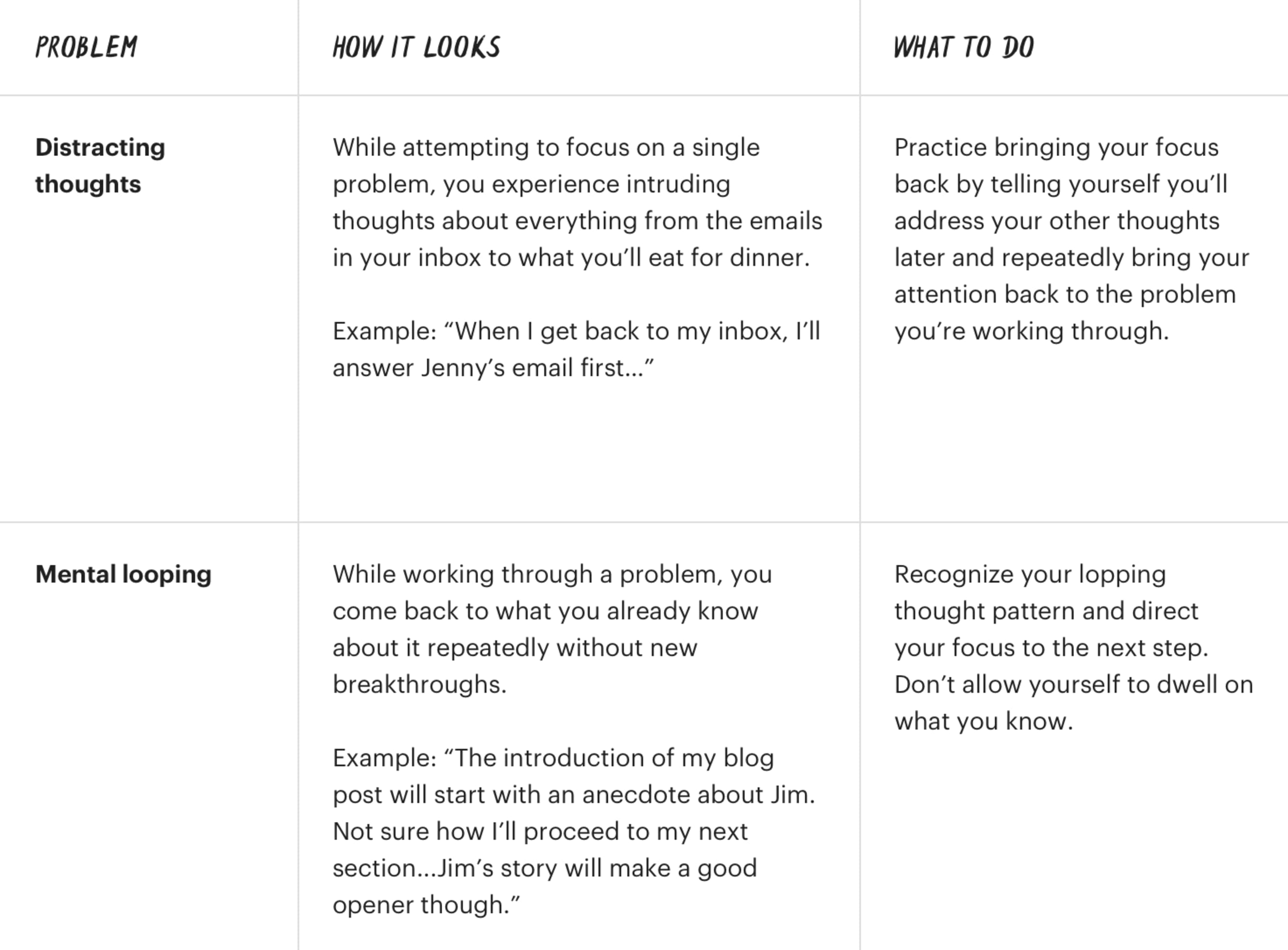
Practice Memory Games
Working on your memory is yet another tactic Newport recommends to prime your mind for deep work. The focus that memorization requires is beneficial when it comes time to sit down and direct your focus toward an important task at work.
As Newport notes, “A side effect of memory training...is an improvement in your general ability to concentrate.”
Here are a few memory-enhancing exercises to try:
- Practice memorizing a deck of cards
- Learn a song or poem by heart
- Commit a list of words in a foreign language to memory
- Memorize the order of a stack of books
While spending time on an activity you were happy to leave behind in school doesn’t sound enticing, training your memory will enhance your ability to concentrate and improve your capacity to complete deep work.
Eliminate Digital Distractions
While priming our minds to prioritize focus is effective, eliminating distractions altogether can be even more powerful in developing a deep work practice. While some of the “network tools” we use are obvious distractions, there are many that exist in a gray area. They take time away from high-leverage activities but can also provide huge benefits. For instance, time spent scrolling through Twitter can be wasteful and stretch on for hours if we’re not careful. However, it can also be a useful platform for creating visibility around work, connecting with interesting people, and exposing yourself to new ideas.
This section will dive into the best way to address these tradeoffs and select tools that truly support our highest-held goals.
Choose Your Digital Toolset Wisely
Newport suggests that “to master the art of deep work...you must take back control of your time and attention from the many diversions that attempt to steal them.”
This means being more selective about the tools we use, rejecting the “Any-Benefit Approach to Network Tool Selection” and embracing the “The Craftsman Approach to Tool Selection.”
The Any-Benefit Approach to Network Tool Selection: You’re justified in using a network tool if you can identify any possible benefit to its use, or anything you might possibly miss out on if you don’t use it.
The Craftsman Approach to Tool Selection: Identify the core factors that determine success and happiness in your professional and personal life. Adopt a tool only if its positive impacts on these factors substantially outweigh its negative impacts.
The Craftsman Approach demands that we be more discerning when deciding which apps we let into our lives and which ones we opt to delete. We’re forced to choose quality over quantity and only use tools that support our high-level goals. Here’s Newport’s precise framework to apply this mindset to your digital life:
- Identify your most important goals at work and in life
- List the top 2-3 activities required to achieve each goal
- Assess each tool you presently use to see if they have a significantly positive impact, significantly negative impact, or neutral impact on the activities you outlined above
- Eliminate the tools that do not have a significantly positive impact that outweighs the negative impacts
Here’s a concrete example of how to apply this framework:
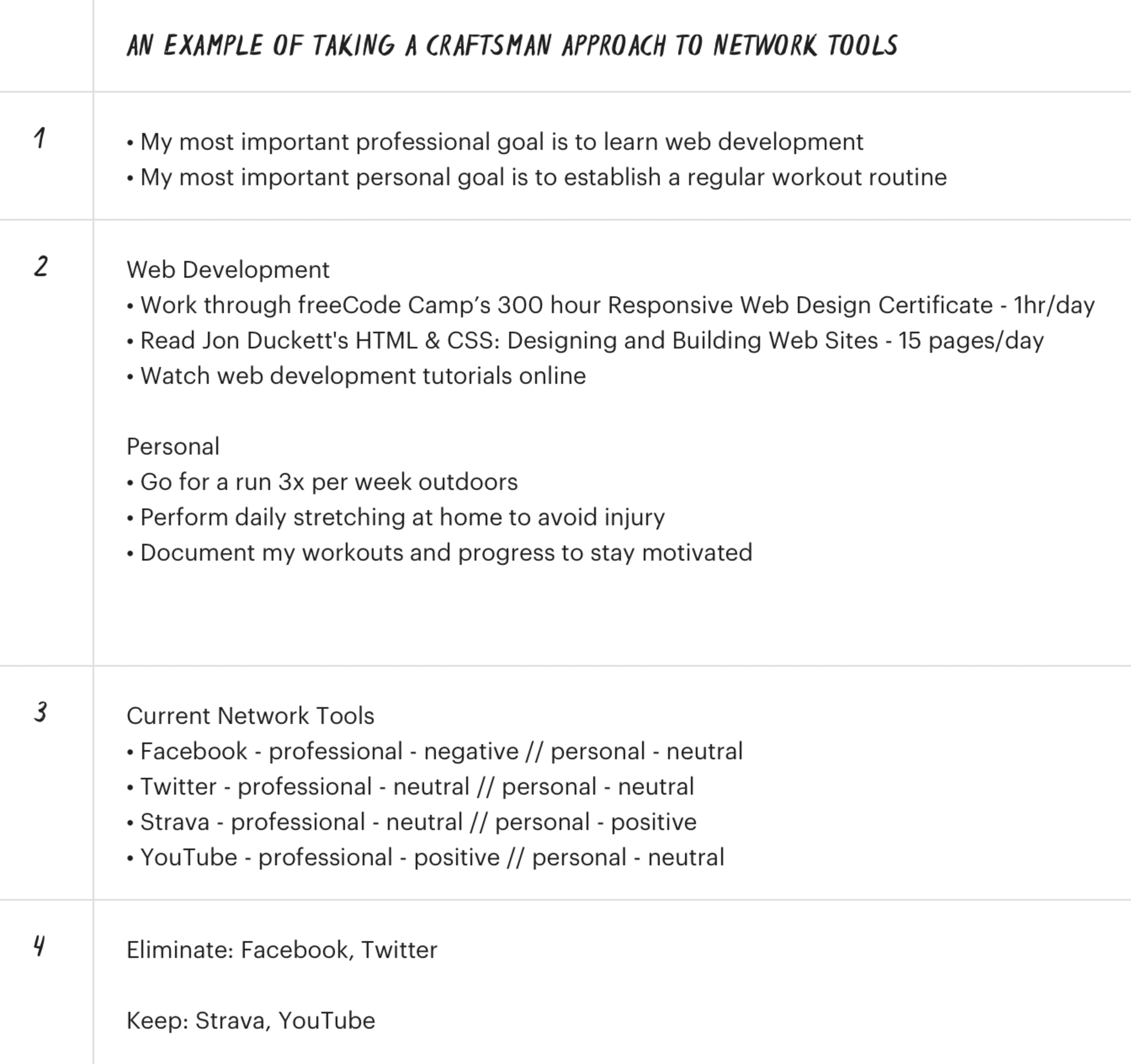
By aligning the digital tools you use with your goals and the key activities required to achieve them, you open the door to achieving excellence in everything you do by harnessing the power of focus.
Stop Using Social Media
In an idea he expands on significantly in his more recent book Digital Minimalism, Newport suggests a self-imposed social media ban for thirty days. While he acknowledges that social media “can be fun,” he urges us also to recognize that it’s a “distraction among many threatening to derail you from something deeper.”
If the apps and websites you use on a daily basis are usurping your efforts to engage in deep work, Newport’s proposed digital declutter is worth pursuing. Delete apps like Twitter, Instagram, Facebook, Snapchat, and TikTok from your phone and resolve not to access them on your desktop device.

After thirty days, Newport suggests asking yourself the following questions about each social media platform you resolved not to use:
- “Would the last thirty days have been notably better if I had been able to use this service?”
- “Did people care that I wasn’t using this service?”
You may be surprised by the answers: many find these services are not as central to their lives as they once believed, and they’re happier and more fulfilled without them. You may find the same. Or not. Regardless, it’s worth exploring if these tools are linchpins in your life or empty pastimes.
Find Replacements for Internet Entertainment
We’ve established that there’s an upper limit to the amount of deep work you can accomplish each day and that you should make space for downtime to enhance your ability to concentrate when you need to. However, downtime has come to mean watching Netflix, scrolling through YouTube, and flipping through new sites for content that catches our eye.
Resist the urge to entertain yourself with the internet, and seek out better leisure activities to maximize your downtime. Newport notes that “to eliminate the addictive pull of entertainment sites on your time and attention, give your brain a quality alternative.”
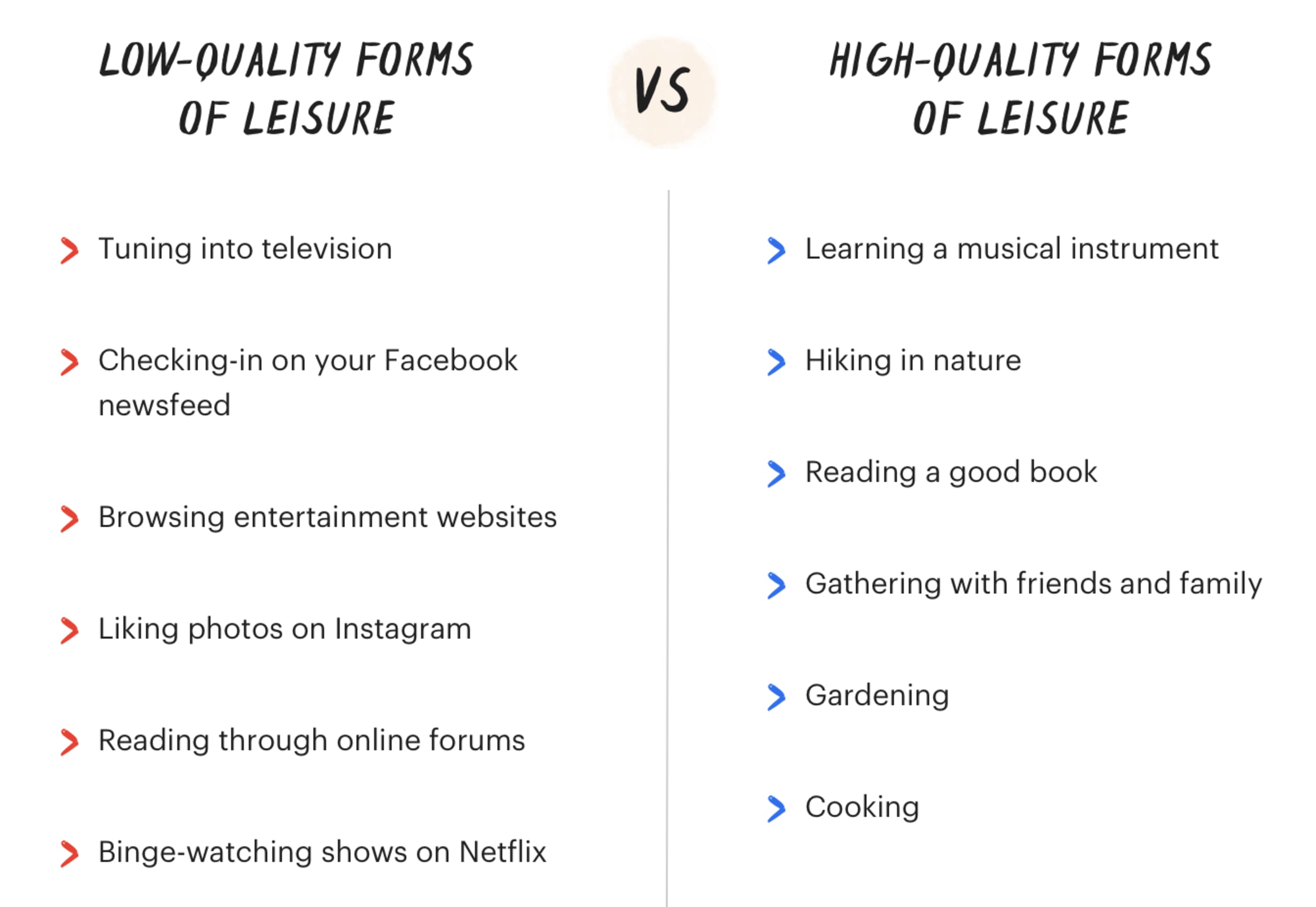
Without quality alternatives to addictive online sites, we’re tethered to our devices in a way that’s not conducive to protecting our attention. Substituting high-quality leisure for online entertainment will help you resist the urge to use the internet as a crutch when we’re bored and loosen the hold that social media and online apps have on our attention.
Purge Shallow Work From Your Life
Maximizing deep work in your schedule, honing your ability to perform it, and reducing distractions are all important parts of the equation. The missing piece we haven’t discussed is removing shallow work from your day-to-day. Of course, eliminating all shallow work is impossible. There will always be administrative and logistical tasks you need to attend to; sending emails, booking work travel, and submitting expense reports. However, there’s a lot of shallow work that can be culled in an effort to maximize your time spent on deep work. This will enable you to push your career and personal pursuits forward.
Schedule Your Day Methodically
Starting your day with a plan is the best way to approach deep work. While it’s important to acknowledge a day typically won’t go exactly as planned, it’s important to set a strategy regardless.
Newport recommends that you “schedule every minute of your day.” While this may sound drastic, this time-blocking approach to productivity isn’t as extreme as it sounds. Simply divide your work day into blocks and assign activities to each one (including room for meals and breaks). This method also forces you to be thoughtful about batching similar tasks. For instance, if you have two people you need to call and three people you need to email, combine those tasks into one block of shallow work after a deep work session.
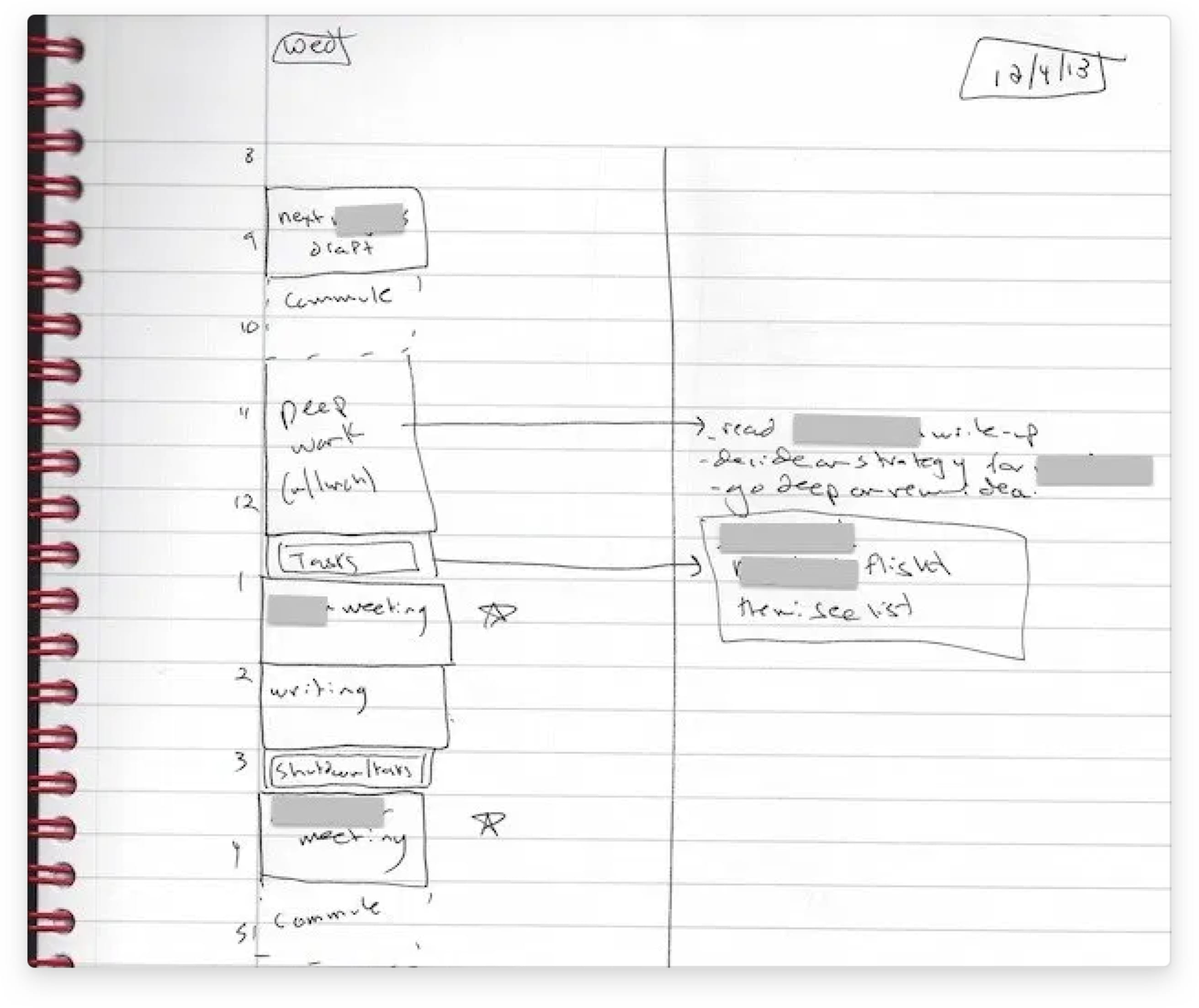
There are two common issues that arise when you schedule your day:
- You incorrectly estimate how long tasks will take
- New tasks arise, displacing what you initially planned
These should be taken in stride rather than frustrate you. Over time, you’ll become better at estimating how long a task will take and can learn to default to overestimation. You can also make use of “overflow conditional blocks,” where you add buffer slots to your schedule if you don’t know how long something will take. This will provide you with more time if you go over your estimate or reserve another block for a different task.
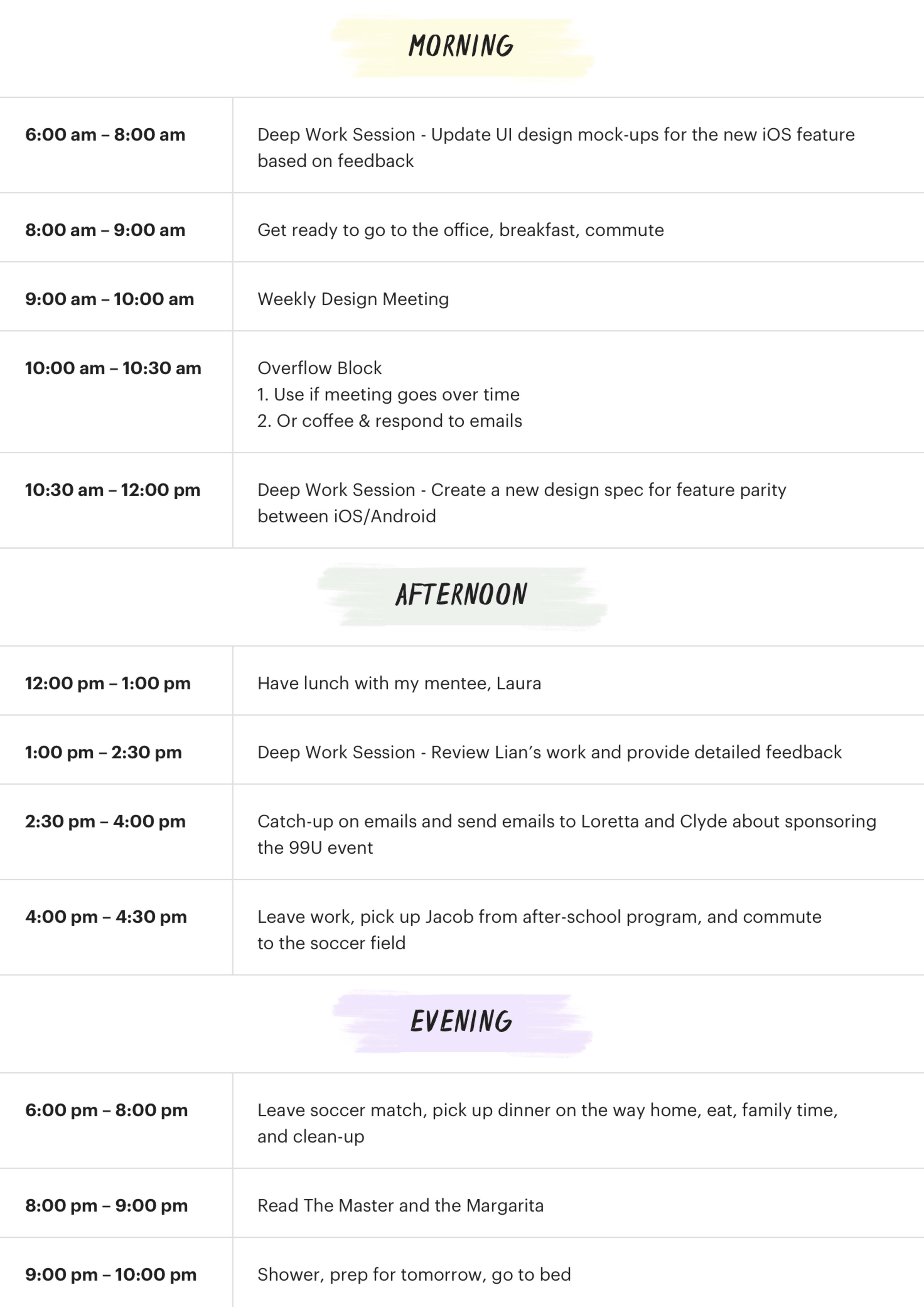
The point of time blocking isn’t to create a schedule you can stick to perfectly each day. Instead, this exercise forces you to be more intentional with your time and how you direct your attention.
Assign Shallow and Deep Grades to Your Work
In order to focus on deep work and decrease shallow work, it’s important to distinguish which is which. Assigning a simple “deep” or “shallow” grade to the work you have planned is a quick way to determine where you should focus your time most intently.
Here are a few questions you can ask yourself to determine if a task qualifies as deep work:
- Does this task require focused attention?
- Does this task require specialized training or knowledge?
- Does this task create new value in the world?
- Would this task be difficult to replicate?
If you can easily answer “yes” to most of the questions above, the task likely falls under the category of “deep work” and is worth your effort to prioritize in your schedule.
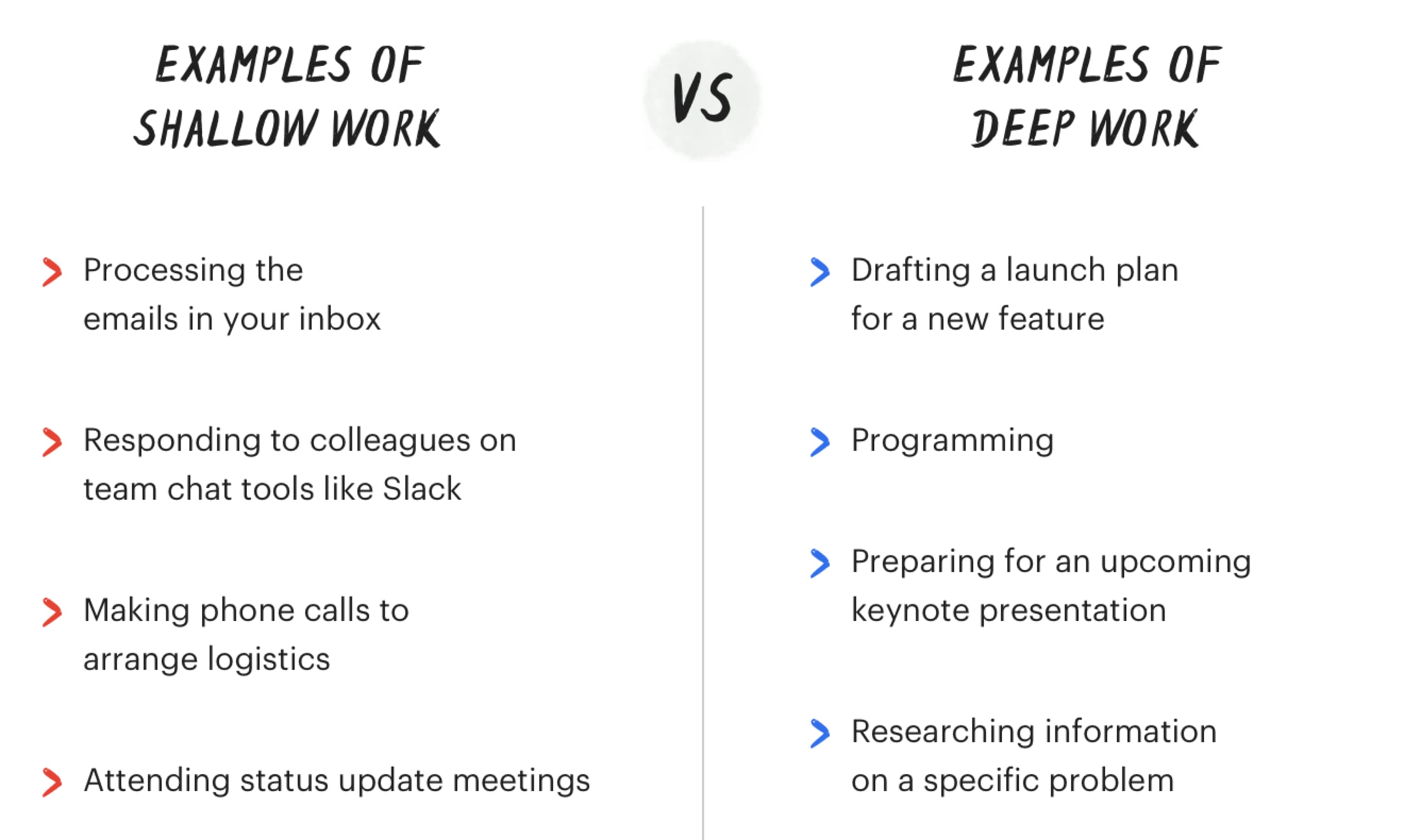
While it’s not always clear where work falls on the shallow to deep spectrum, taking time to make the distinction for yourself is valuable in creating a hierarchy for your attention with deep work at the top.
Get Your Boss on Board With Deep Work
The modern workplace is biased towards shallow work. Companies make little to no effort to quantify the costs of shallow work, failing to recognize the dollar amount lost when skilled people don’t focus on deep work. They default to the status quo of constant connectivity and regularly occurring meetings instead of prioritizing long-term impact. Busyness is viewed as a sign of getting things done rather than its direct adversary.
However, all hope is not lost. Many are open to the idea of minimizing information overload and distractions at work, allowing deep work to flourish, and helping employees do their best work. Your boss might be one of them. Explain the concept of deep work and shallow work to them, using examples from your own typical workday. Then, ask them this question: “What percentage of my time should be spent on shallow work?”
By getting support from your manager to spend time on deep work and getting an approximate “shallow-to-deep ratio”, you’ll be better able to structure your time at work and know that your boss supports you in unchaining yourself from your inbox and delving into work that provides deep value to your company. If there are specific ways your manager can support you in your quest for deep work, let them know.
Limit Your Workday
Embrace “fixed-schedule productivity.” Rather than working ridiculous hours to accomplish your goals, constrain yourself to a typical eight-hour workday that forces you to be ruthless choosing where to spend your time and energy.
Remove shallow work from your schedule, don’t entertain opportunities that do little to serve your goals, and be liberal in your use of the word “no.” With limited time at your disposal, you’ll need to be methodical in how you plan. As Newport notes, “A commitment to fixed-schedule productivity...shifts you into a scarcity mindset”. This necessarily makes you consider how you spend your time more wisely and raises the bar for what gets your attention and what is relegated to the unimportant pile.
Make Yourself Inaccessible
Most of us have a steady drip of emails entering our inbox each day. This takes up mind space and attention that could be devoted to deep work. Newport argues that email is the “quintessential shallow activity is particularly insidious in its grip on most knowledge workers’ attention.”
However, there are several strategies we can use in dealing with email and loosening its grip on our attention:
Make Senders Do More Work When They Email You
- Make senders work for your email addresses; don’t list it publicly or have it on your website.
- Ask senders to filter themselves by having different emails or separate contact forms for different queries
Do More When You Send or Respond to Emails
- Reduce the back-and-forth of emails with a “process-centric approach to email.” By sending more thorough and complete correspondence, you’ll close the loop on a conversation more quickly.
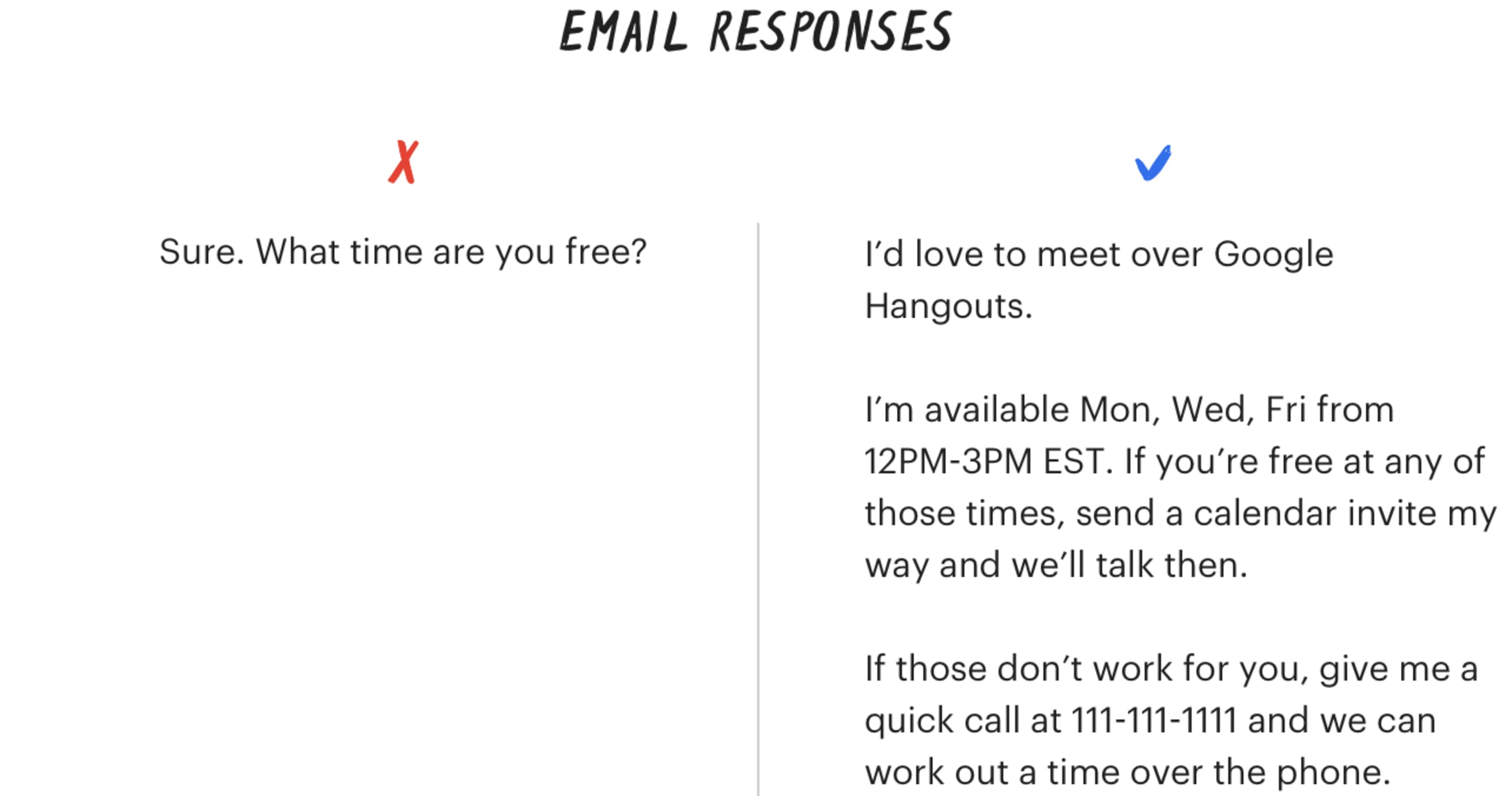
Don’t Respond
Not every email that lands in your inbox requires a response. For some, the default line of thinking is that “it’s the sender’s responsibility to convince the receiver that a reply is worthwhile”. However, this is a controversial belief. Some suggest that not responding to emails is rude, and others recommend never responding to your emails at all.
These three rules may help you find a middle ground that saves your sanity while still remaining open to opportunities that may arise. Newport recommends that you don’t respond to a message with these qualities:
- It’s ambiguous or otherwise makes it hard for you to generate a reasonable response.
- It’s not a question or proposal that interests you.
- Nothing really good would happen if you did respond, and nothing really bad would happen if you didn’t.
While uncomfortable to begin with, you may find these ground rules for responding to emails save you time and energy that you can direct towards deep work.
Start Your Deep Work Practice
With strategies at your disposal to cultivate a deep work practice, the only thing left to do is start. We’ve compiled a Todoist template that pulls all the action items in this guide into a single project. You’ll find all the tasks you’ll need to keep you accountable for building a deep work habit from scratch.
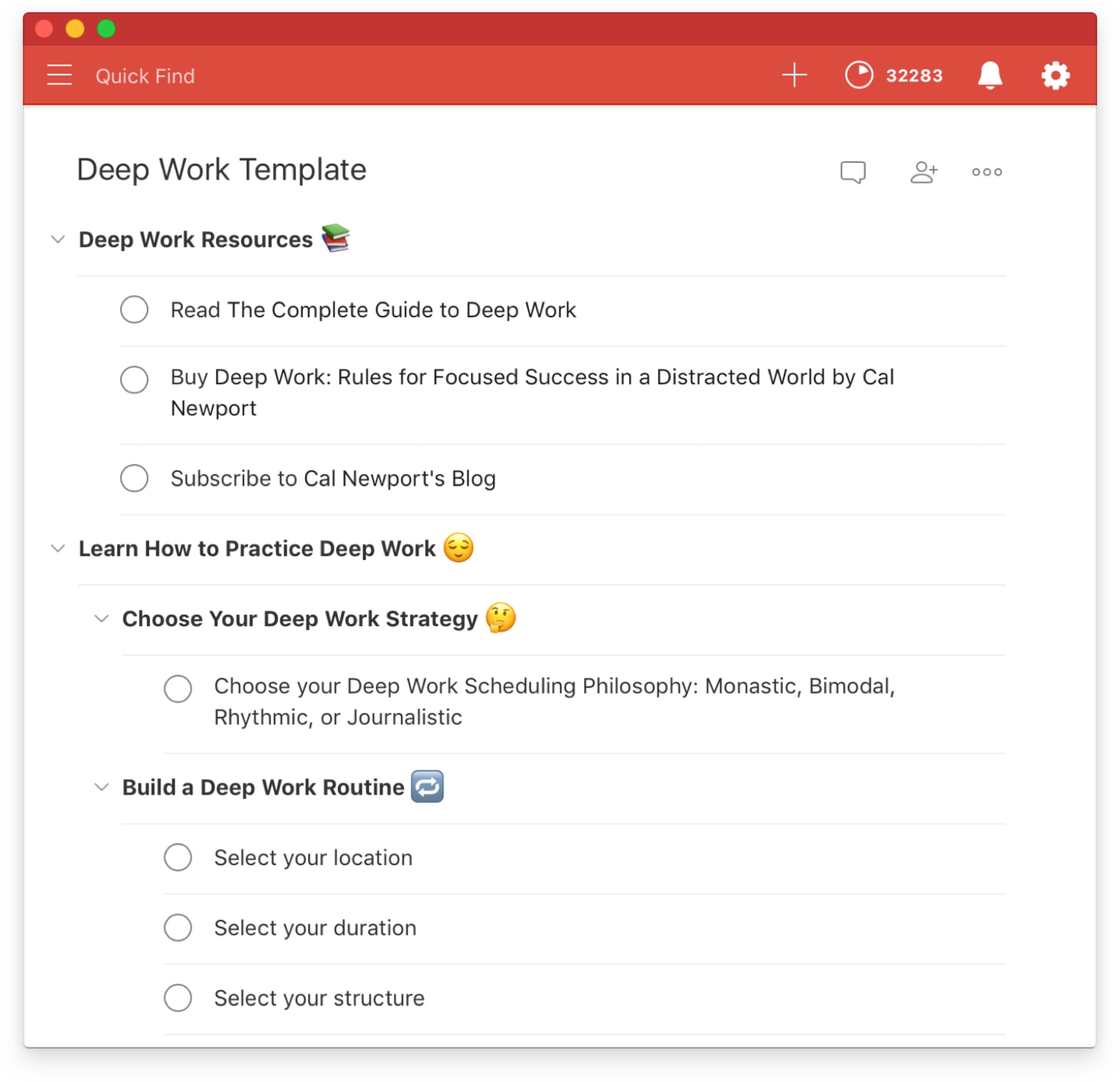
Import the Deep Work Todoist Template to get started on your deep work practice!
In an ever-changing technological landscape, one thing remains constant: your propensity to succeed is directly proportional to your ability to perform deep work. In the absence of focus, we’re unable to carry out high-leverage activities that add value to the world and position ourselves as key contributors to interesting and important projects.
In applying the concepts throughout this guide, you can learn to harness your most important resource, your attention. Equipped with the principles to work deeply, you’ll move from success to success, tackling the challenges that arise with the power of focus.

